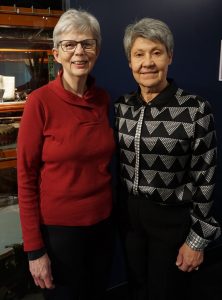In the early 1980s two enterprising women set out to design and build the perfect timpani. Rebecca Kite and Barbara Allen met when both were graduate students at Indiana University (IU), Bloomington. They believed that they could improve upon timpani and achieve the purest possible sound. “Our goal was to build an instrument that had a better sound and worked better – a timpani that we could be passionate about,” Kite says. Words by Dr. Nick Johnson. Adapted from Classical Music Indy’s NOTE Magazine.
The Quest for the Perfect Timpani
By the end of the 1980s, Kite and Allen achieved their goal. It was a long and difficult journey, involving a 100-year-old copper shop in Ohio, a self-designed machine shop in Bloomington, metal workers in Indianapolis, several patents and a remarkable amount of grit and determination.
To appreciate their story, you have to know a little about timpani. These kettle-drums have been used in Western concert music since the late 1700s by composers like Mozart and Haydn. Beethoven later used timpani to add emphasis and volume at climactic moments in his symphonies, such as in his famous Symphony No. 9. Timpani makers continued to refine the instrument in the 1800s, and the basic design as we know it was standardized in the late 1800s.
Although they are imposing, powerful instruments, traditional timpani have musical and practical limitations:
- They can be difficult to tune quickly and accurately.
- The frame limits some of the instrument’s resonance.
- They are difficult to move and expensive to purchase and maintain.
Kite and Allen saw an opportunity to fix these issues. Several years after graduate school, Kite worked for IU and was in charge of nearly 60 timpani housed at the music school. This experience made her intimately familiar with the design of the drums. Timpani are essentially copper bowls suspended by a metal frame with a skin or synthetic head stretched tight. What makes them unique is the ability to change pitch by adjusting the tension of the head. Each of these elements presented Kite and Allen with opportunities for improvement.
One of the first hurdles was designing and building custom copper bowls for the drums. Kite says most timpani sacrifice tone quality by using shallower bowls than is mathematically ideal for sound waves. This limits the purity of tone and resonance.
To get deeper copper bowls, Kite and Allen had to build them by hand. They traveled to study with a 102-year-old coppersmith in Ohio who had “modernized” his equipment in the 1920s. He told them they were the first women ever to come to his shop, and offered to train the pair if they came back with a pattern for their drums.
The wizened artisan probably never expected to see them again, but that was before he knew the degree of their determination and ingenuity. “When we were in school, we weren’t even allowed to take shop classes,” Allen says. “But we did take home economics, and drum patterns are remarkably similar to dress patterns.” 
The two returned to the shop a few months later with a pattern for a perfect parabolic drum bowl. Training with the master, they learned how to make their own tools, pound the copper into the proper shape and bind it into a sturdy bowl. Using these skills, the pair then built their own machine shop in Bloomington, custom designed for manufacturing their timpani.
Over the next decade they produced numerous timpani under the name GP Percussion. Orchestras, universities, military bands and professional percussionists all over the United States use the instruments. Kite and Allen, however, are no longer building timpani. Kite is now primarily a marimbist and timpanist, and Allen is a political science professor at Carleton College. Their innovations, however, have inspired numerous drum makers to adopt several of their ideas, although, as Kite puts it, “What we did has not been fully replicated.”
Kite and Allen are inspirational to drum makers and young, entrepreneurial musicians alike, especially women in a male-dominated field. “You can get a degree in something, you can be really good at something, and it may take a long time before your particular idea comes about,” Allen says. “The creative spark that pushes you forward is really the important thing in life. And finding those interesting projects, solving those puzzles, that’s the deal. Not getting exactly what you want, the way you thought you were going to get it.”
You can see a set of timpani designed and built by Kite and Allen on display at the Rhythm! Discover Center in downtown Indianapolis. Also included in the exhibit are original tools, patterns and patents from their tenure as timpani makers.






Leave a Reply